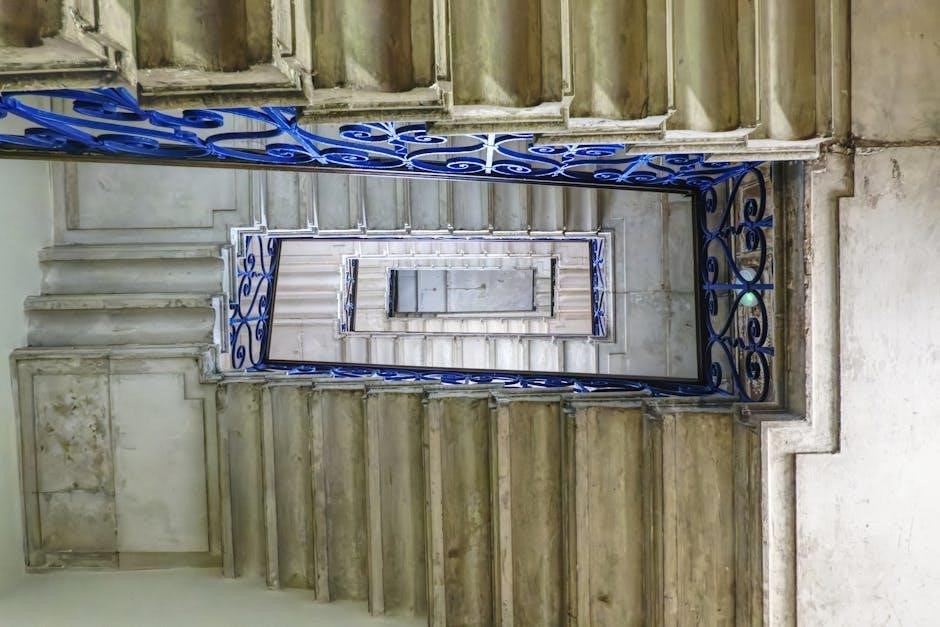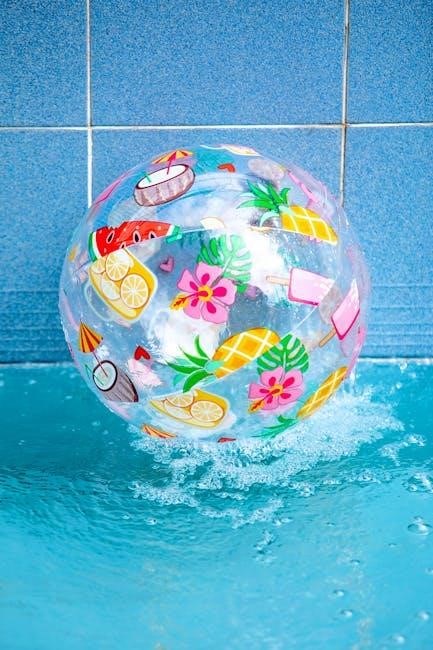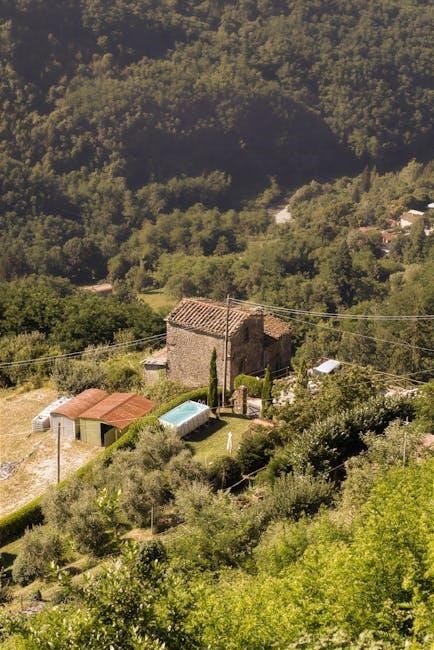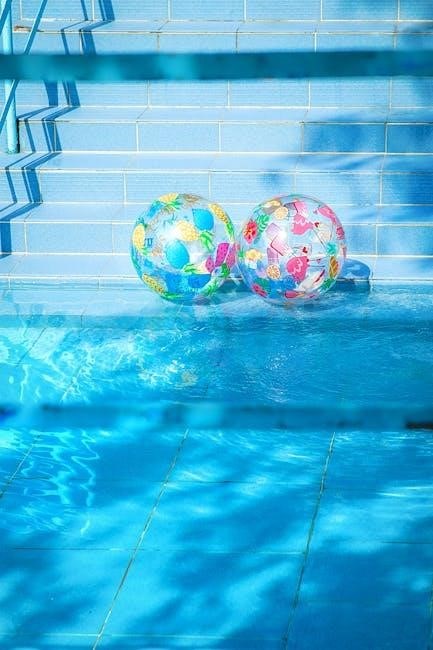
-
By:
- elizabeth
- No comment
intex pool installation instructions
Intex Pool Installation Instructions: A Comprehensive Guide
Discover essential steps for a successful Intex pool setup, including site preparation, frame assembly, liner installation, and safety tips. Follow detailed instructions to ensure a safe and enjoyable swimming experience for years to come.

Pre-Installation Preparation

Before starting your Intex pool installation, proper preparation is crucial to ensure a smooth and safe setup process. Begin by selecting a flat, level area with good drainage, avoiding low spots where water may collect. Ensure the site is clear of debris, rocks, and obstructions that could damage the pool liner. Check for underground utilities and overhead obstructions to comply with safety guidelines. Next, gather all necessary tools and equipment, such as a shovel, measuring tape, and leveling tools. Mark the pool area with stakes and twine, adding 1 foot of extra space around the pool’s perimeter. Use a line level to ensure the ground is even, making adjustments as needed. Proper preparation also includes verifying local regulations and ensuring electrical components meet safety standards, such as GFCI requirements for pool pumps. Finally, unpack and organize all components to avoid missing parts. Taking the time to prepare the site thoroughly will help prevent issues during installation and ensure your pool operates safely and efficiently.
Understanding the Components
Before starting the installation, it’s essential to familiarize yourself with the various components of your Intex pool. The pool frame consists of metal or plastic parts that provide structural support, while the pool liner is the waterproof layer that holds the water. The pump and filter system are crucial for maintaining clean and safe water circulation. Additionally, you’ll find hardware such as screws, bolts, and connectors to assemble the frame. A ground cloth is often included to protect the liner from sharp objects, and a pool cover may be provided to keep debris out when the pool is not in use. Understanding each component’s purpose and how they connect is vital for a successful installation. Take time to organize and identify each part according to the instruction manual to ensure nothing is missing or damaged. Proper knowledge of these components will help you navigate the assembly process confidently and avoid potential issues down the line.
Site Selection and Ground Preparation

Selecting the right location for your Intex pool is critical for safety, functionality, and aesthetic appeal. Choose a flat, level area with adequate space to accommodate the pool’s dimensions, ensuring at least one additional foot of clearance on all sides. Avoid areas with overhead power lines or obstructions like trees, as these can pose safety risks or create maintenance challenges. Ideal locations receive partial sunlight to prevent excessive heat buildup and are close to a water source and power outlet for convenience. Once the site is chosen, clear the area of debris, rocks, and vegetation to ensure a smooth installation process. Use a shovel to level the ground, checking with a carpenter’s level to ensure evenness. Mark the pool’s perimeter with a rope or hose to visualize the space. Finally, lay down a ground cloth to protect the pool liner from sharp objects. Proper site selection and ground preparation are foundational steps that ensure a safe and hassle-free installation experience.

Unpacking and Inventory
Begin by carefully unpacking your Intex pool kit to ensure all components are included and undamaged. Lay out the contents on a clean, dry surface to organize the parts. Refer to the provided manual or inventory list to account for every item, such as the pool frame, liner, pump, filter, hoses, and hardware. Inspect each component for signs of damage or defects, especially the liner, as any punctures or tears could lead to leaks. If any parts are missing or damaged, contact the manufacturer immediately for replacements. Once everything is verified, sort the components by category to streamline the assembly process. This step is crucial to avoid delays and ensure a smooth installation. Pay special attention to smaller hardware, like screws and connectors, as they are easy to misplace. Use the provided instructions to identify each part and its purpose. Organizing your workspace beforehand will save time and reduce frustration during assembly. Double-checking the inventory ensures you’re fully prepared to move forward with the setup.
Assembling the Pool Frame
Begin by laying out the pool frame components on a flat, stable surface near your prepared site. Follow the manufacturer’s instructions to identify and connect the frame pieces, starting with the base rings and working your way up. Use a wrench to secure the bolts and connectors, ensuring tightness but avoiding overtightening, which could damage the metal. As you assemble, double-check that each joint is aligned properly and the frame remains level. If the frame becomes uneven, adjust the legs or base rings accordingly. Once the frame is fully assembled, walk around it to ensure stability and structural integrity. Make sure all connections are secure and the frame stands upright without wobbling. Finally, tighten all bolts gradually in a star pattern to maintain even pressure and prevent warping. A properly assembled frame is essential for the pool’s safety and longevity, so take your time and verify each step carefully.
Once the frame is ready, you’ll be prepared to move on to installing the liner.

Installing the Pool Liner
Installing the pool liner is a critical step that requires precision to ensure a proper fit and prevent damage; Start by carefully laying the liner over the assembled pool frame, aligning the edges with the frame’s circumference. Smooth out any wrinkles or air pockets by gently tugging the liner evenly around the pool. Use the provided liner locks or clips to secure the liner to the frame, ensuring it is tightly fastened without overstretching. Check for proper alignment and a smooth surface, making adjustments as needed to avoid creases that could lead to leaks. Once the liner is securely attached, inspect all seams and connections for tightness and integrity. Finally, begin filling the pool with water gradually, monitoring the liner’s fit as it expands. Avoid using the pool until the liner has settled and the water is properly balanced. Proper installation ensures a safe and durable pool liner, essential for enjoyable swimming experiences.
After installing the liner, proceed to fill the pool with water and set up the pump system.

Filling the Pool with Water
Filling your Intex pool with water is a straightforward process, but it requires attention to detail to ensure safety and proper functionality. Before you begin, make sure the pool liner is correctly installed and the pump system is connected. Attach a garden hose to a nearby water source and connect it to the pool’s inlet valve. Turn on the water supply and allow the pool to fill slowly. Monitor the water level to avoid overfilling, ensuring it reaches the recommended level as indicated in the manufacturer’s instructions.
As the pool fills, inspect the liner for any signs of stretching or misalignment. If you notice any wrinkles or air pockets, gently smooth them out while the liner is still pliable. Once the pool is full, test the water chemistry using a test kit and balance the pH and chlorine levels as needed. Finally, ensure the pump and filter system are operational to maintain clean and safe water. Always follow local water usage guidelines and safety precautions when filling your pool.
Setting Up the Pump and Filter System
Setting up the pump and filter system is crucial for maintaining clean and circulating water in your Intex pool. Begin by connecting the pump to the pool’s inlet valve, ensuring it is securely attached to the pool frame. Next, attach the provided hoses to the pump’s inlet and outlet ports, making sure they are tightly secured to prevent leaks. Place the pump on a level, stable surface near the pool and plug it into a Ground Fault Circuit Interrupter (GFCI)-protected electrical outlet to ensure electrical safety.
Once connected, turn on the pump and allow it to circulate the water. Check for any air leaks in the hoses or connections, as these can reduce the system’s efficiency. Refer to the manufacturer’s instructions for specific guidance on priming the pump and setting the correct flow rate. Finally, ensure the filter cartridge is properly installed and clean before operation. Regularly maintain the filter system by cleaning or replacing the cartridge as needed to keep your pool water clear and safe for swimming.

Ensuring Electrical Safety
Electrical safety is paramount when installing and operating your Intex pool. Always ensure that the pool pump and filter system are connected to a Ground Fault Circuit Interrupter (GFCI)-protected outlet, as required by the National Electric Code (NEC). Storable pools, including Intex models, must have a GFCI integrated into the pool pump cord assembly, adhering to NEC 680.31 and 680.32. These codes are part of Article 680, which specifically addresses electrical safety for swimming pools and related equipment.
Before powering up the system, inspect all cords and connections for damage or wear. Never operate the pump or filter if there are signs of electrical damage. Additionally, keep all electrical components at least 12 feet away from the pool water to prevent accidental contact. If you’re unsure about any aspect of the electrical setup, consult a licensed electrician to ensure compliance with local regulations and safety standards. Proper electrical safety measures will protect you and your family from potential hazards while enjoying your pool.

Final Checks and Testing
Once the pool is assembled and filled with water, perform a thorough inspection to ensure everything is functioning correctly. Check the pool frame for stability, ensuring all connections are secure and properly tightened. Inspect the liner for any signs of damage, wrinkles, or improper seating, as these could lead to leaks or structural issues.
Test the pump and filter system by running it continuously for at least 30 minutes to ensure it operates smoothly and effectively circulates the water. Verify that all hoses and connections are watertight and free of leaks. Additionally, check the water level to make sure it is within the recommended range for optimal performance.
Finally, conduct a safety inspection of the surrounding area, ensuring that the pool is inaccessible to unsupervised children and pets. Test any additional features, such as pool lights or jets, if applicable. Once all systems are confirmed to be working properly, your Intex pool is ready for safe and enjoyable use.

Maintenance Tips
Regular maintenance is crucial to ensure your Intex pool remains clean, safe, and functional. Start by skimming the pool surface daily to remove floating debris, such as leaves or insects, using a pool skimmer. Vacuum the pool floor weekly to keep it free from dirt and sediment. Clean the filter according to the manufacturer’s instructions, as a dirty filter can reduce water circulation and clarity.
Check the water chemical levels regularly, ensuring proper balance of pH, chlorine, and alkalinity. Imbalanced chemicals can damage the pool liner or pose health risks to swimmers. Inspect the pool liner and frame for any signs of wear or damage, addressing issues promptly to prevent leaks or structural weakness.
Test the water clarity and cleanliness by running the pump for the recommended amount of time each day. Finally, store pool accessories and toys properly when not in use to avoid contamination. By following these maintenance tips, you can extend the lifespan of your Intex pool and enjoy a safe, refreshing swimming experience.
Troubleshooting Common Issues
During the lifespan of your Intex pool, you may encounter common issues that require prompt attention. One of the most frequent problems is leaks, which can occur in the liner, connections, or valves. To identify the source, use a dye test or inspect the area for water droplets. If a leak is found, apply a vinyl patch kit specifically designed for pool liners.
Another issue is damage to the liner, often caused by sharp objects or excessive sunlight. Inspect the liner regularly and repair minor tears immediately. If the pump fails to start, check the power supply, ensure the filter is clean, and verify that all connections are secure. Algae growth is another common problem, which can be prevented by maintaining proper chemical balance and regular cleaning.
Cloudy water can result from poor filtration or insufficient chlorine levels. Run the pump continuously for 24-48 hours and adjust chemical levels as needed. Addressing these issues early ensures your pool remains safe and functional for years to come.
Safety Precautions
Ensuring safety is paramount when installing and using your Intex pool. Always follow the manufacturer’s guidelines and take necessary precautions to prevent accidents. Start by ensuring the installation site is level and stable to avoid structural issues. When handling electrical components, such as the pump and filter system, ensure they are properly grounded and installed according to local electrical codes. Never operate the pool equipment without a Ground Fault Circuit Interrupter (GFCI) to prevent electrical shocks.
During use, always supervise children and pets when they are near or in the pool. Install a fence or barrier to restrict unsupervised access. Avoid using the pool during thunderstorms or extreme weather conditions. Regularly inspect the pool and its components for damage or wear and tear, addressing any issues promptly.
Additionally, maintain proper chemical levels in the water to ensure it is safe for swimming. Keep rescue equipment nearby and learn basic first aid techniques. By prioritizing safety, you can enjoy a fun and secure swimming experience for years to come.
Compliance with Local Regulations
Before installing your Intex pool, it is crucial to comply with local building codes, zoning laws, and safety regulations. Check with your local government to obtain any necessary permits or approvals for above-ground pool installations. Ensure that your pool meets requirements for fencing, barriers, and gate safety to prevent unauthorized access, especially for children.
Electrical installations for pool pumps and filters must adhere to the National Electric Code (NEC) standards, particularly sections like NEC 680.31 and 680.32, which pertain to pool equipment. A Ground Fault Circuit Interrupter (GFCI) is often mandated for pool pumps to prevent electrical shocks.
Additionally, familiarize yourself with local health and safety regulations regarding pool water quality and chemical usage. Some areas may require inspections or certifications for pool installations. Failure to comply with these regulations could result in fines or the need to remove the pool.
Always consult local authorities or a licensed professional to ensure your Intex pool setup meets all legal and safety standards in your area.
Installing an Intex pool can be a rewarding experience, providing countless hours of fun and relaxation for you and your family. By following the detailed steps outlined in this guide, you can ensure a safe and successful setup. Remember to always prioritize proper preparation, adherence to safety guidelines, and regular maintenance to extend the life of your pool.
While the process may seem daunting at first, breaking it down into manageable tasks makes it achievable. Whether you’re a seasoned DIY enthusiast or a first-time installer, taking the time to understand each step will lead to a professional-quality result.
Enjoy the satisfaction of completing your Intex pool installation and the joy of cooling off during those warm summer days. With proper care, your pool will become a cherished part of your backyard for years to come. Happy swimming!